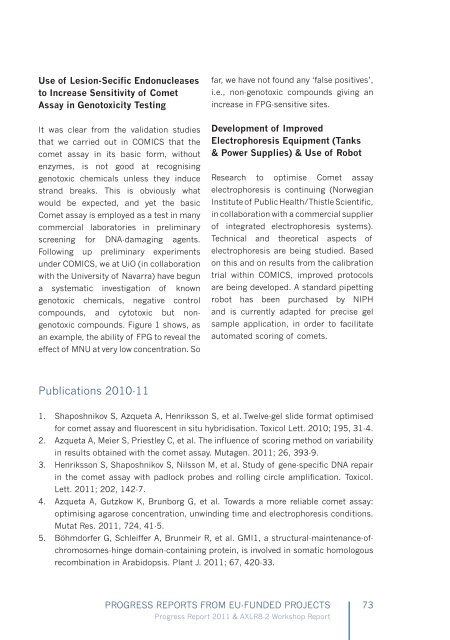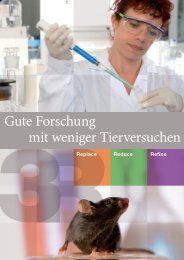Create successful ePaper yourself
Turn your PDF publications into a flip-book with our unique Google optimized e-Paper software.
Use of Lesion-Secific Endonucleases<br />
to Increase Sensitivity of Comet<br />
Assay in Genotoxicity Testing<br />
far, we have not found any ‘false positives’,<br />
i.e., non-genotoxic compounds giving an<br />
increase in FPG-sensitive sites.<br />
It was clear from the validation studies<br />
that we carried out in COMICS that the<br />
comet assay in its basic form, without<br />
enzymes, is not good at recognising<br />
genotoxic chemicals unless they induce<br />
strand breaks. This is obviously what<br />
would be expected, and yet the basic<br />
Comet assay is employed as a test in many<br />
commercial laboratories in preliminary<br />
screening for DNA-damaging agents.<br />
Following up preliminary experiments<br />
under COMICS, we at UiO (in collaboration<br />
with the University of Navarra) have begun<br />
a systematic investigation of known<br />
genotoxic chemicals, negative control<br />
compounds, and cytotoxic but nongenotoxic<br />
compounds. Figure 1 shows, as<br />
an example, the ability of FPG to reveal the<br />
effect of MNU at very low concentration. So<br />
Development of Improved<br />
Electrophoresis Equipment (Tanks<br />
& Power Supplies) & Use of Robot<br />
Research to optimise Comet assay<br />
electrophoresis is continuing (Norwegian<br />
Institute of Public Health/Thistle Scientific,<br />
in collaboration with a commercial supplier<br />
of integrated electrophoresis systems).<br />
Technical and theoretical aspects of<br />
electrophoresis are being studied. Based<br />
on this and on results from the calibration<br />
trial within COMICS, improved protocols<br />
are being developed. A standard pipetting<br />
robot has been purchased by NIPH<br />
and is currently adapted for precise gel<br />
sample application, in order to facilitate<br />
automated scoring of comets.<br />
Publications 2010-11<br />
1. Shaposhnikov S, Azqueta A, Henriksson S, et al. Twelve-gel slide format optimised<br />
for comet assay and fluorescent in situ hybridisation. Toxicol Lett. 2010; 195, 31-4.<br />
2. Azqueta A, Meier S, Priestley C, et al. The influence of scoring method on variability<br />
in results obtained with the comet assay. Mutagen. 2011; 26, 393-9.<br />
3. Henriksson S, Shaposhnikov S, Nilsson M, et al. Study of gene-specific DNA repair<br />
in the comet assay with padlock probes and rolling circle amplification. Toxicol.<br />
Lett. 2011; 202, 142-7.<br />
4. Azqueta A, Gutzkow K, Brunborg G, et al. Towards a more reliable comet assay:<br />
optimising agarose concentration, unwinding time and electrophoresis conditions.<br />
Mutat Res. 2011, 724, 41-5.<br />
5. Böhmdorfer G, Schleiffer A, Brunmeir R, et al. GMI1, a structural-maintenance-ofchromosomes-hinge<br />
domain-containing protein, is involved in somatic homologous<br />
recombination in Arabidopsis. Plant J. 2011; 67, 420-33.<br />
PROGRESS REPORTS FROM EU-FUNDED PROJECTS<br />
Progress Report 2011 & AXLR8-2 Workshop Report<br />
73




